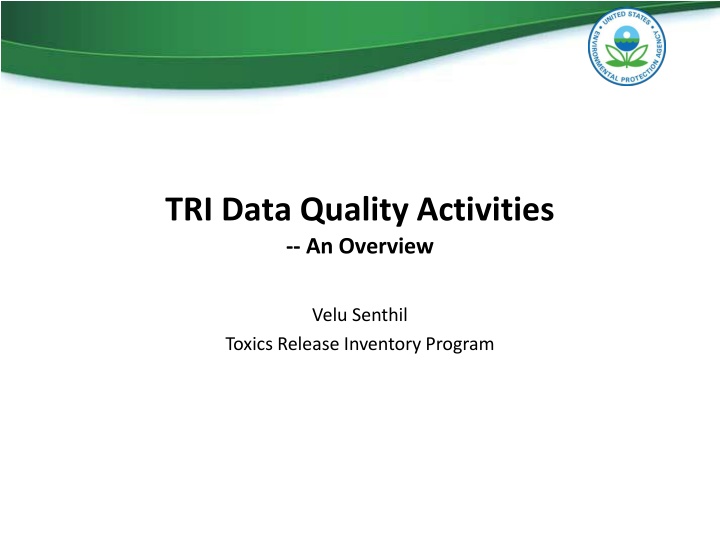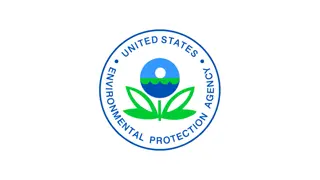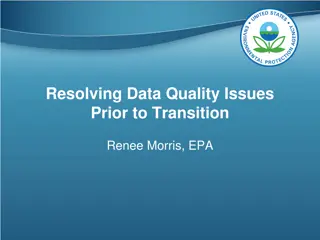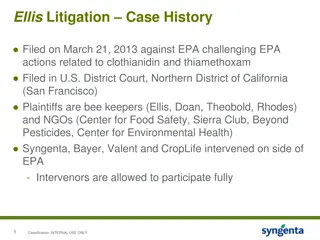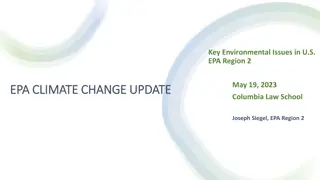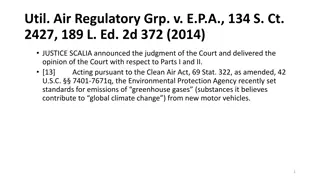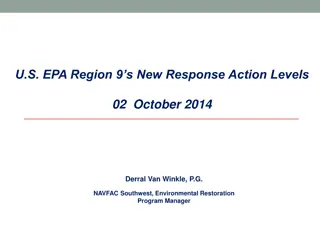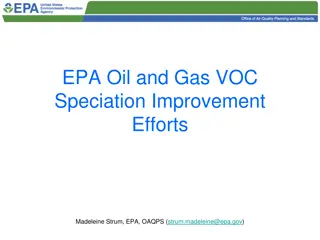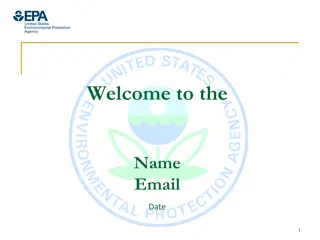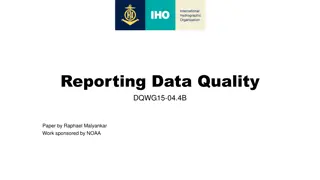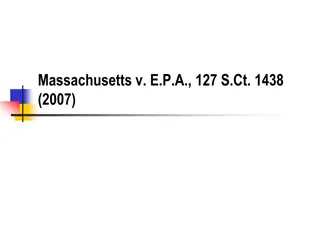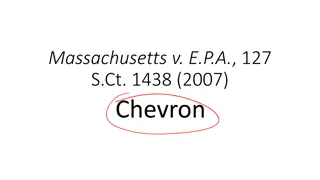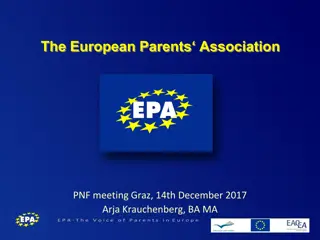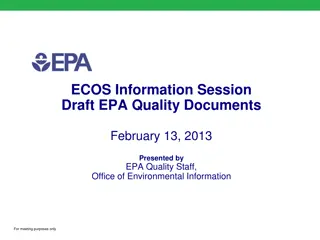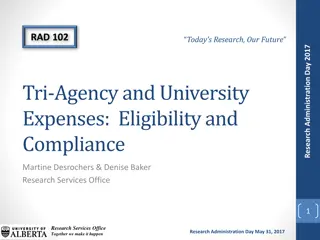Ensuring Quality of TRI Data: EPA's Efforts and Guidelines
EPA plays a crucial role in ensuring the quality of Toxics Release Inventory (TRI) data through year-round efforts such as guidance, outreach, training, and assistance. Measures like using readily available information, making reasonable estimates, and following data flow and quality activities help maintain the accuracy and reliability of TRI data. EPA's TRI reporting guidance, training programs, and assistance resources contribute to enhancing data quality for informed decision-making.
Download Presentation

Please find below an Image/Link to download the presentation.
The content on the website is provided AS IS for your information and personal use only. It may not be sold, licensed, or shared on other websites without obtaining consent from the author.If you encounter any issues during the download, it is possible that the publisher has removed the file from their server.
You are allowed to download the files provided on this website for personal or commercial use, subject to the condition that they are used lawfully. All files are the property of their respective owners.
The content on the website is provided AS IS for your information and personal use only. It may not be sold, licensed, or shared on other websites without obtaining consent from the author.
E N D
Presentation Transcript
TRI Data Quality Activities -- An Overview Velu Senthil Toxics Release Inventory Program
Best Readily Available Information Use readily available data (including monitoring data) collected pursuant to other provisions oflaw Where such data are not readily available, use reasonableestimates If available data known to be non-representative, facilities must make reasonable estimates using the best readily availableinformation Base reasonable estimates using published emission factors, material balance calculations, or engineeringcalculations Do not use emission factors or calculations if more accurate dataavailable TRI does not require additional monitoring or measurement beyond whatother laws/regulations require or are part of routine plantoperations What is readily available can change over time (e.g., newinformation) Recommendation: Carefully document decision making used (e.g.,assumptions &calculations) 2
How Does EPA Help to Ensure the Quality of TRI Data? TRI data quality efforts year-around Guidance, outreach, training, assistance TRI-MEweb, Data ProcessingCenter Electronic Facility dataprofiles Data qualitycalls Enforcement 3
TRI Reporting Data Flow and Data Quality Activities EPA Receives Reports TRI-MEweb& DPC verify reports CDX - CentralDataExchange DQ - DataQuality DPC - DataProcessingCenter TRI-MEweb Toxics Release Inventory Made EasyWeb NA - NationalAnalysis TRI - ToxicsRelease Inventory 4
TRI Guidance Guidance General Reporting Forms and Instructions Chemical Specific IndustrySpecific Questions & answers Guide Me 5
Training, Assistance and Outreach Online training Basic Advanced Classroomtraining Some regions Private parties TRI Assistance Call center Regional and HQstaff 6
TRI ME web, TRI DPC,eFDP TRI MEweb TRI DPC eFDP 7
Why Data Quality Calls? Conduct Data Quality Calls bi-annually Summer &Winter National Analysis Data Quality Calls in Summer: focused on National Analysis Ad Hoc Data Quality Calls in Winter: focused on specific issues Benefits of Data QualityCalls Assures higher-quality National Analysis dataset Delve directly into specific data quality issues Identify enhancements for TRI-MEweb Compare TRI data to other EPA datasets 8
Analyses for Data QualityCalls EngineeringAnalysis Industry-Specific Chemical-Specific Increasers / Decreasers Analysis Other Data Quality Issues Persistent Bioaccumulative Toxic (PBT) Chemicals HAPs, Carcinogens, RSEI TRI-MEweb Certification Issues, P2 issues Comparison of TRI Data with Other EPA & Non-EPAData National Emissions Inventory (NEI) Discharge Monitoring Reports (DMR) Chemical Data Reports (CDR) Biennial Reporting System (BRS) Risk Management Program (RMP) Tier II Reports 9
NEIData Office of Air and Radiation (OAR) releases National Emissions Inventory (NEI) data once every 3 years Hazardous air pollutants (HAPs) from industrial facilities Use data from states, TRI and facilities test data Most of the HAPs are also listed on TRI chemical list Hypothesis: Certain facilities that report to NEI are also expected to report to TRI Many TRI sectors are also covered in NEI TRI listed HAPs 10
Comparison of NEI-TRI Air Releases Downloaded NEI data from Emissions Inventory System (EIA) Portal Adjusted NEI and TRI CASnumbers Combined EIS-TRI crosswalk table with updatedinformation Identified facilities with significant variations of air release values between TRI and NEI 11
CDR Data Office of Chemical Safety and Pollution Prevention (OCSPP) collects chemical data reports (CDR) from manufacturingfacilities Manufacturing volumes, number of employees and other information 5015 individually listed chemicals on TSCA Inventory Approximately 770 chemicals reported to CDR Overlaps with 271 TRI chemicals and chemical categories Hypothesis: Certain facilities that report to CDR are expected to report to TRI Chemical manufacturing industrysectors TRI listedchemicals Exceeds employee threshold 12
DMR Data Office of Waste Management (OWM) issues NPDESpermits Facilities submit Discharge Monitoring Reports (DMRs) to states and EPA works with states to populate that data in ICIS-NPDES Reporting frequency varies as specified in permits DMR tool pulls information from NPDES database Hypothesis: Certain facilities with NPDES permits are expected to report to TRI Covered industry sector TRI listedchemicals Exceeds activity threshold amounts 13
TRI-Tier 2 Comparison-1 Background on Tier 2 andTRI States maintain Tier 2 Reports Several TRI Chemicals are reported under Tier 2 Reporting What is Included in this Analysis? Approximately 25 states R2: NJ, & NY R3:VA R4: AL, FL, GA, MS, NC, SC, &TN R1: CT, MA, NH, VT, ME, & RI R7: IA, &NE R6: AR, &TX R5: MI, MN, &WI R10: ID &WA R9: AZ, &NV R8: ND, MT, & UT 14
TRI-Tier2 Comparison-2 Most States do not give access to their Tier 2 Reports Hypothesis: Certain facilities that report Tier 2 Reports are expected to report directly to TRI (under section 313 ofEPCRA) Manufacturing industry sectors TRI listed chemicals Exceeds employee threshold 15
TRI-Tier 2 Comparison-3 AnalyticalApproach Downloaded Tier 2 data from E-Plan, individual states and regional Tier 2 coordinators Confirmed chemical identity between Tier 2 and TRI chemicals using Chemical Abstracts Service (CAS) numbers Obtained NAICS and number of Employees for Tier 2 facilities Matched Tier 2 facilities with FRS and TRI database Identified possible TRI non-reporters and never-reporters Double-checked facilities operational status 16
TRI-RMP Comparison Hypothesis: Certain facilities that report RMP Reports are expected to report directly to TRI (under section 313 ofEPCRA) RMP industry sectors also be covered under TRI TRI listed chemicals and RMP chemicals Exceeds employee threshold Quantities in-Process Identified non-reporters and never-reporters 17
Results and Follow Up Results Under-Reporters / Over-Reporters Non-Reporters Chemical Facility Never-Reporters FollowUp Data Quality Calls Enforcement 18
TRI Facilities Revisions RY07-14 #Facilities that Revised* 2015 1864 2026 1423 2094 1178 1005 546 Total Facilities 23359 22769 21894 21737 21742 21847 21897 21783 Total Facilities* 23126 22555 21698 21542 21562 21708 21772 21657 RY 2007 2008 2009 2010 2011 2012 2013 2014 *These counts omitted multi-establishment facilities. PercentRevised 8.7% 8.3% 9.3% 6.6% 9.7% 5.4% 4.6% 2.5% TRI Facilities Revision Rate - RY07-14 15.0% 30000 20000 10.0% 10000 5.0% 0 0.0% 2013 2014 2007 2008 2009 2010 2011 2012 #Facilities that Revised* TotalFacilities* PercentRevised 19
Revisions of Facilities with New andExisting Tech Contacts RY07 - 14 Percent Facilities with No New TechContacts that Revised Contacts* 23126 2015 7.5% 22555 1864 7.6% 21698 2026 8.8% 21542 1423 5.9% 21562 2094 9.2% 21708 1178 4.9% 21772 1005 4.0% 21657 546 2.4% *These counts omitted multi-establishment facilities. Facilities with atleastone new Tech. Contact* 6321 5759 4498 4422 5137 5047 5210 5068 # Facilities thatrevised and had a new Tech. Contact* 749 580 507 418 575 361 335 142 Percent Facilitieswith New Tech Contacts that Revised 11.8% 10.1% 11.3% 9.5% 11.2% 7.2% 6.4% 2.8% #Facilities that Revised* Facilitieswith no new Tech. RY 2007 2008 2009 2010 2011 2012 2013 2014 TotalFacilities* 16805 16796 17200 17120 16425 16661 16562 16589 TRI Facilities with New and Exixsting Tech Contacts Revisions - RY07-14 15.0% 10.0% 5.0% 0.0% 2007 2008 2009 2010 2011 2012 2013 2014 Percent Facilities with No New Tech Contacts that Revised Percent Facilities with New Tech Contacts thatRevised 20
Scope of TRI Program Data Quality Activities EPA undertakes a range of data quality efforts so that EPA can assureTRI data users that published TRI information is of known quality and of sufficient quality to meet the needs of intended enduses. TRI Data Quality Assurance and Control Model 1) Detection of anomalies / reportingissues 3) Identification and implementation of changes that would remediate known errors and reduce the prevalence of reporting errors in the future 2) Investigation of potentialreporting errors 4) Review of the efficacy ofthe remediationactions 21
Enforcement Data Quality Over-reporting Under-reporting Non-Reporters Facility Chemical(s) Never Reporters 22
Summary TRI Program is committed to helping facilities submit high quality TRI data: Data Quality Calls Guidance TRI-MEweb Training TRI Information Center Outreach 23
Contact Information Velu Senthil: (202)-566-0749;senthil.velu@epa.gov 24
Help us Improve! You will receive an email with a link to a survey to review the course(s) you attend at the Emissions Inventory Training Workshop. Please take a few moments to let us know about your experience this week. We welcome your feedback!
